Brief

The holiday shopping season is gaining momentum. Signs still point to healthy spending, and Amazon once again has positioned itself to gain share. With an estimated market share of 7%–8% of Bain-defined holiday retail sales, Amazon is expected to capture about 50% of total holiday growth this season. In this issue, we look at Amazon's strategy and examine how retailers can capture more than their fair share of the other half.
Holiday shopping update
The holiday rush is on, and the shopping environment remains strong:
- Macroeconomic indicators are favorable. The U-6 unemployment rate, which includes unemployed, underemployed and discouraged workers, dropped to 7.9% in October, reaching its lowest level since 2006. Disposable income was up (1.2% year over year growth this September versus 1.1% last September), as was the Consumer Confidence Index (125.9 in October, a 25% increase over October 2016's 100.8). Consumers continue to be optimistic and have more money in their pockets as the holiday shopping season begins.
- Stock market momentum continues. The Dow Jones Industrial Average and the S&P 500 Index continue their climb to all-time highs, increasing 6% and 4%, respectively, between September 1 and October 31. During the same period last year, both indexes fell by more than 1%.
- Consumers still have a lot of shopping to do. Bain's 2017 Holiday Shopper Pulse, a survey conducted in collaboration with Research Now, suggests that as of November 1 the majority of consumers were still gearing up to shop. Fewer than 22% of shoppers claimed to have most of their holiday shopping done.
- Leaders are gaining share of web traffic. This year Bain partnered with SimilarWeb to track web traffic at 250 top retailers during September and October. The data suggests a consolidation of web traffic toward online leaders, a continuation of the winners-take-most trend in e-commerce. The top 10 retailers gained 2.7 percentage points of share, claiming 63.9% of the total web traffic over the period. Amazon had the largest share of that traffic (31.4%), up 2.2 percentage points from the same period last year.
What's fueling Amazon's holiday growth?
Amazon's overall growth is well documented. Its North America revenue last quarter was up 35% year over year; Prime membership is at 90 million subscribers, representing about 6 in 10 US households; and gross merchandise value (GMV) sold on Amazon grew approximately 30% year over year in the last three years, outpacing average growth of 14% in US e-commerce overall. Amazon doesn't report the gross merchandise value it sells through its US website, but estimates suggest the company has a pattern of growing its share of the e-commerce market fastest in the second half of the year, from Prime Day in July through the holiday season (see Figure 1).

What's fueling this growth? Amazon remains focused on its three-spoked "flywheel": offering "Earth's biggest selection," using scale to lower prices and providing a best-in-class, fast, easy and convenient customer experience (see Figure 2). The company also continues to win over valuable Prime members, who provide a wealth of data to Amazon and spend more than two times as much as non-Prime members. Of course, some of this difference in spending is due to the fact that Prime members tend to be wealthier and bigger online spenders. However, in partnership with Earnest Research, we looked at how much new Prime members spend on Amazon.com in their first year of Prime membership. We found that their growth in spending was 36 percentage points higher than that of a control group (see Figure 3).

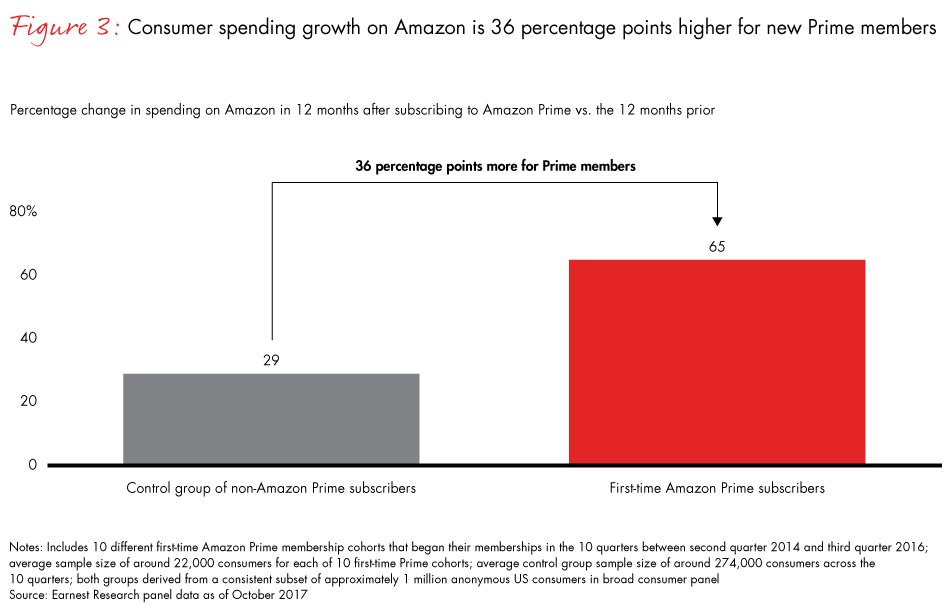
Also contributing to Amazon's growth is its expansion outside its traditional retail business, including heavy investments in its business-to-business products and business-to-consumer services. In addition, Amazon Web Services contributes about 75% of Amazon's profit, allowing Amazon to invest in lower prices in the retail business and improve its machine learning algorithms with an additional platform.
Beyond what the company does is how it does it. With his "Day 1" manifesto, Jeff Bezos insists that the company maintain a start-up mentality to avoid the complacency that often follows success. According to Bezos, "it is always Day 1," which means Amazon must focus on innovation, fast decision making and an everyday obsession with customers. What does Day 1 look like this season? Heading into the holidays, Amazon has bolstered prior playbooks and rolled out new experiments across assortment, price and customer experience, all in an effort to maximize customer cheer.
Assortment
Amazon wins the "largest assortment" award hands down, with well more than 400 million products on the site. That's more than six times the 60 million products Walmart offers on its site. The company's traffic gains continue to attract more apparel and beauty brands to the site. It also launched a one-year promotion on October 15 that lowered sellers' fees from 15% to 8% for nonperishable grocery products priced below $15. This move encourages merchants to sell smaller-pack grocery products in its Marketplace, broadening Amazon's grocery selection. In October Amazon also added a revamped Amazon Handmade Gift Shop, providing artisan merchants with a space to list handcrafted products and shoppers with gift options that rival those of Etsy and other competitors. But this year's biggest holiday headlines are all about Amazon's own products: exclusive brands and private-label goods you can only find shopping on Amazon.
Voice-enabled devices: "Hey Alexa, wrap up a new Echo"
Amazon is not so quietly competing to win the voice wars this holiday season. The company's voice-operating platform, dubbed "Alexa," underlies a full line of Echo devices now featured prominently on its website, on its app and in its advertising. What is Alexa? On verbal cue, Alexa can order products from Amazon.com, tell you the weather, play a song, order an Uber or a pizza, turn off your lights and complete 20,000+ other tasks. Although Alexa may not be best in class at understanding natural language (Google Assistant wins that distinction), Amazon is betting that broad distribution of its Echo devices will entice more developers to build more skills on its platform, in the process encouraging more shoppers to buy these devices. Moreover, with third parties building Alexa-powered devices like the Sonos One and Harman Kardon Allure, Alexa is also gaining a more compelling ecosystem of device families on which it can run.
At stake is not only the $4 billion US smart-speaker market, of which Amazon currently controls 70% of users, but also the profound impact that voice will have over how people shop and what they buy. With voice ordering, customers can't see a full shelf or scroll through product listings. Instead, Alexa typically provides two product results for voice-activated shopping searches. To better understand how the rise of Alexa will impact brand visibility, Bain conducted a voice ordering test across a representative mix of categories using Amazon Echo devices. We learned that Alexa's recommendations for unbranded searches bias toward prior purchases, Amazon's Choice products and its own private labels (see Figure 4).
- Repurchases. If customers order a product similar to one already in their Amazon order history, Alexa asks if they want to repurchase the previous product before providing additional options. This creates barriers for newer brands and can have a profound impact on categories where shoppers typically purchase a broad repertoire of brands (many fast-moving consumer goods categories, for example).
- Amazon's Choice. For first-time purchases, Amazon first looks to recommend "Amazon's Choice" products. Amazon doesn't disclose how it chooses these products, but the process likely combines sales, Prime eligibility, ratings and rates of return. When an Amazon's Choice product isn't available, Alexa recommends the top search result instead (the first non-sponsored product on its site).
- Private label. If a search falls within a category in which Amazon offers private-label products, Alexa recommends the private-label products 17% of the time. Given that these products represent only about 2% of total first-party unit volume sold, the online retailer clearly positions its own private labels favorably in voice shopping.
- Sponsored products. In about 5% of Alexa's first recommendations, we found that Alexa's script skips over the Amazon's Choice or top search result part of its response. Instead, Alexa directly names the brand and description for the first product recommendation. We found that Alexa does this for product listings marked "sponsored" on Amazon.com. In a world in which consumers tend to disregard products labeled "sponsored," Alexa's voice search control makes sponsorship all the more powerful, given that Alexa does not disclose listings as sponsored.
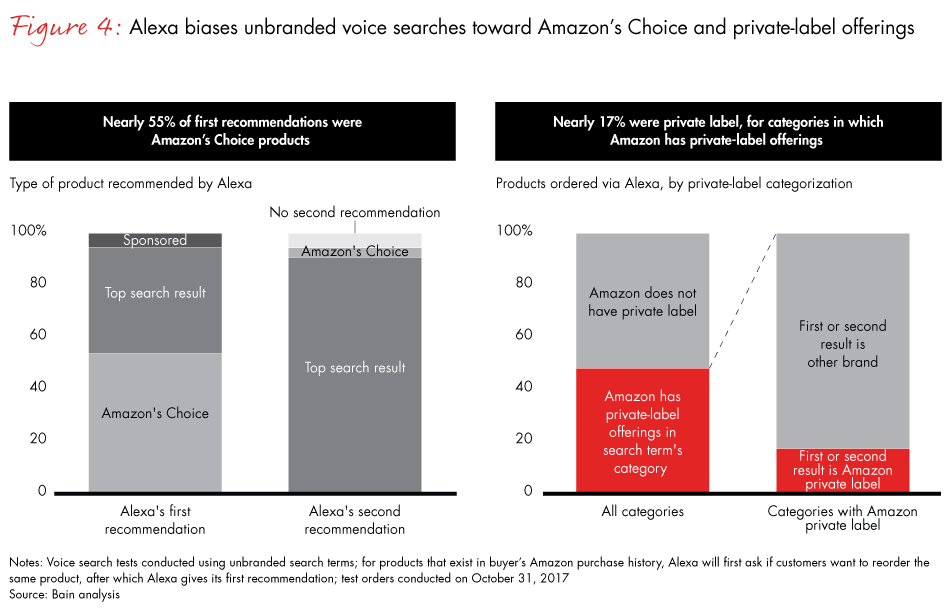
Why is this so important? RBC Capital Markets predicts that by 2020, 128 million Echo devices will be installed in households and used by them for an average of $400 in shopping spend per customer. As the Echo family continues to grow and voice ordering becomes more and more prevalent, Amazon will take an increasingly strong hand in determining what products people buy from its vast assortment. This bias toward private-label products and possibly other top brands is going to cost secondary brands and force them to find new ways to capture the mindshare of customers. The "endless aisle" just got a lot smaller.
More private labels in the spotlight
Amazon has introduced more than 20 private-label brands in the past two years in apparel, electronics, groceries and more. Including Whole Foods' 365 products, total sales across this portfolio are expected to reach more than $4 billion this year. This holiday season, Amazon brands are front and center, with outsized share of gift guides and search results. For example, 20% of the items featured on the first page of Amazon's "Electronics Gift Guide Under $100" list were private-label products.
Bain also conducted unbranded searches on Amazon.com across more than two dozen popular categories in which Amazon has private-label offerings. We found that Amazon's private-label products make up an average of 11% of first-page search results, with private labels representing as many as 25% to 29% of first-page results in select categories like men's button-down shirts and AA batteries. We uncovered a similar trend in the company's Prime Day promotions this year: Amazon's private-label products were up to 44% of the first-page deals in electronics and other select categories.
Pricing
Amazon wants to be known for low prices, and so far this holiday season it's achieved that goal: more than 70% of Amazon shoppers believe that the online retailer offers good prices, according to Bain's 2017 Holiday Shopper Pulse survey. On November 1, Amazon was one of the first to release its Black Friday deals, with more than 100 million items discounted up to 30%. But despite all these deals, Amazon's prices are not always the lowest, and they change much more frequently than prices do at most other retailers.
Winning with low prices…on most items
This year Bain worked with Market Track to study nuances in Amazon's pricing. Our analysis confirmed that for holiday-related categories like electronics, sports and toys, Amazon remains competitive. For example, in the categories we tested, we found that Amazon offers the absolute lowest price between 17% and 25% of the time and ties for the lowest price between 41% and 57% of the time (see Figure 5). These findings are roughly in line with the data we collected in 2016, which showed that Amazon prices best sellers more aggressively than its full assortment.
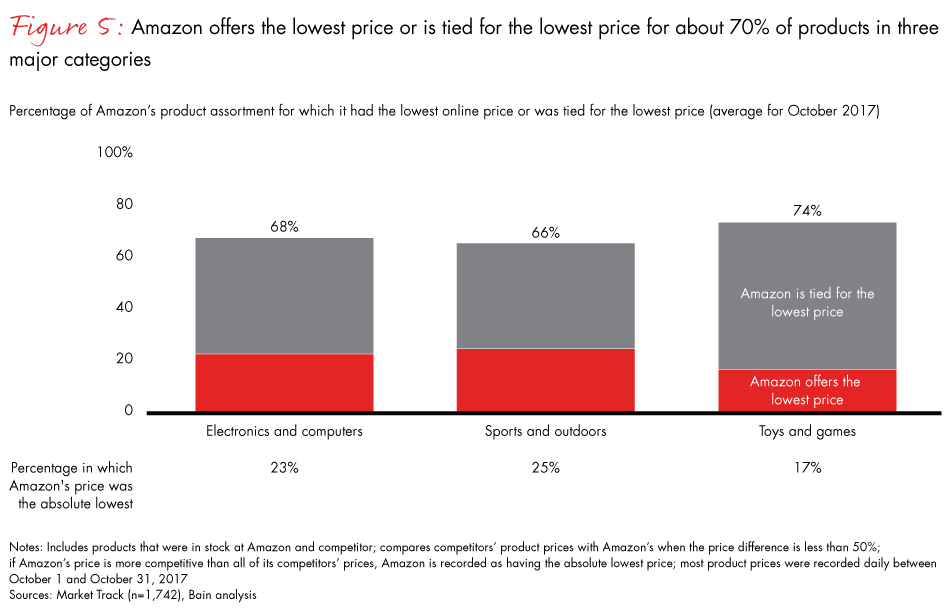
Amazon's pricing strategy also varies by category. For example, in the electronics and computers category we found that on average, Amazon offers the largest percentage discount on the cheapest items. In the sports and outdoors category and the toys and games category, average savings were more uniform across price tiers.
Price transparency or pricing lottery?
The Internet was once heralded for creating full price transparency for customers. Click, click, click, and shoppers could compare offers across several retailers either by visiting the sites or tapping into various comparison-shopping engines. But that clarity is disappearing as prices change day to day, even hour to hour. Amazon continues to change prices day over day more frequently than most of its competitors (see Figure 6), although its competitors have begun to follow suit. For example, last year in the toys and games category, Amazon changed its prices about three times more often than Walmart and Toys "R" Us. This year, in the same category, Amazon is still changing its prices more frequently, but the gap between it and its competitors is much smaller.
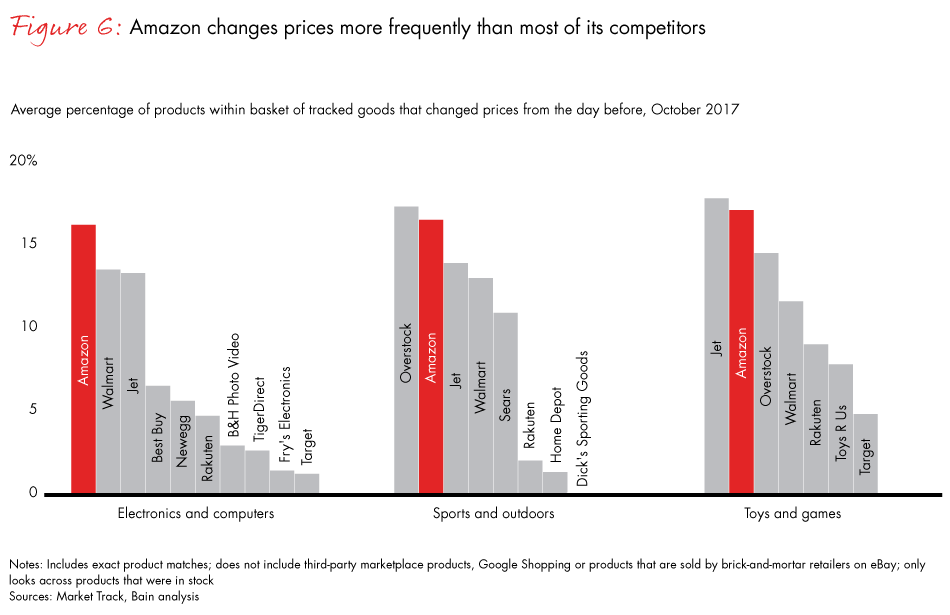
Customers may find price fluctuations disheartening or confusing. Did I really get a good deal? Am I being taken advantage of? Wasn't that item in my basket cheaper yesterday? When we looked at price changes at Amazon and its top competitors over the month of October, we saw some double-digit fluctuations between days. However, looking at the average prices on October 1 and then on October 31, we found that neither Amazon nor its competitors changed their average prices by more than about 2% over the period.
New this season: "Discounts by Amazon"
In recent weeks, Amazon has started to discount goods sold by third parties in its marketplace. The Wall Street Journal reported that Amazon has lowered prices by as much as 9% on some goods. Sellers still receive the list price, while customers capture a bigger discount. This opt-out program may spur sales, but it also creates new complexity for brands and independent sellers. They lose control over pricing and could face sudden inventory depletions or inadvertent violations of their pricing agreements with manufacturers or other retailers. We will keep an eye on how this trends over the holidays.
Customer experience
Amazon is heading into the holiday season with strong customer advocacy. Bain's 2017 Advocacy in US Retail study, conducted in collaboration with ROI Consultancy Services, looked at the Net Promoter Score®1, a measure of customer advocacy and satisfaction, across top retailers (see Figure 7). The study revealed that Amazon has the highest Net Promoter Score among top retailers for many categories, including home products, consumer electronics, and sports equipment and athletic wear. Even in women's clothing, where Amazon has its lowest Net Promoter Score, it remains in the top 50% of retailers.
Amazon's Prime members are its biggest promoters. Prime members have an average Net Promoter Score that is 28 points higher than that of their non-Prime counterparts (see Figure 8), according to Bain's 2017 Holiday Shopper Pulse survey. Also impressive is the fact that Amazon retains 91% of first-year Prime subscribers and 96% of second-year subscribers.
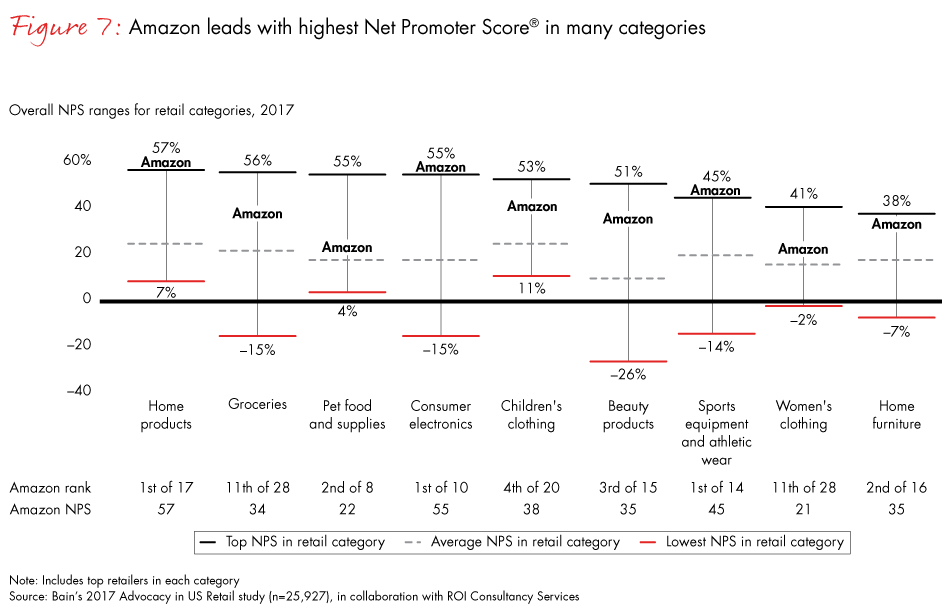

How does Amazon create such happy customers? Throughout the shopping journey, Amazon has found new ways to create promoters—shoppers who buy more, stay longer and share their experiences with friends and colleagues throughout the coming year.
Here are a few examples of how Amazon is experimenting to improve the customer experience this holiday:
- Adding excitement and sparking impulse purchases via Treasure Trucks. These pop-up shops on wheels alert customers via Amazon's mobile app about special one-day sales and have been spotted in more than 25 cities as of November 1. The trucks offer a new sales channel, but perhaps more impactful is the resulting brand awareness and social media buzz.
- Expanding physical availability of its own-brand products. Amazon products are no longer just on Amazon.com or in Amazon stores. Shoppers can find Kindles and Echo products at Kohl's, Whole Foods, Best Buy, Bed Bath and Beyond and many other retail locations. Some Kohl's stores now even offer an Amazon "smart home experience" to inspire shoppers with in-person demos, showcasing the full range of skills that Alexa and its compatible device family have to offer.
- Taking the guesswork out of purchases via augmented reality. Since November 1, customers can use a new AR feature in Amazon's iPhone app to insert virtual versions of products into real-world scenes, visualizing in 3D how anything from an Echo to a new couch looks in their own home or office. While Amazon has some technical fine-tuning to do, and similar technologies already exist at retailers like IKEA and Wayfair, it still has a competitive edge by having the largest number of users of any shopping app.
- Reducing the risk of late deliveries via Seller Flex. By using Amazon's own fleet of trucks for pick-up and delivery of third-party merchants' products, Seller Flex makes more items eligible for Prime two-day shipping.
- Reducing concerns of "porch theft" via Amazon Key and Cloud Cam. Customers who purchase the smart lock system can grant one-time authorization for delivery personnel to drop off packages inside their front doors instead of leaving them outside. Available in select zip codes across 37 metropolitan areas, these Amazon Key customers will also be able to provide unattended access to more than 1,200 types of professional service providers—from home cleaners to dog walkers—via Amazon Home Services.
Every brand and retailer needs an Amazon strategy
Despite Amazon's headline-grabbing growth, other retailers shouldn't give up. Amazon isn't killing retail. Retailers' lack of customer-centric innovation is killing retail. That can change, but not if it's business as usual. Winners will learn from Amazon by adopting a healthy appetite for risk taking and making use of their unique assets. We pose three questions:
- If Amazon bought your business, what would it do differently than you do today?
- What can you do to delight customers that Amazon can't do (at least yet)?
- When might you want to collaborate with Amazon?
What would Amazon do?
Amazon's acquisition of Whole Foods sparked immediate speculation about what the online giant would do with the 470-store grocer. It didn't take long to find out. On the day the deal closed, prices on highly visible products fell and signs about home delivery blanketed stores. Whole Foods private-label products soon appeared on Amazon's website while Amazon private-label products (Echo devices, for example) were on display in some stores. The company also announced plans to integrate Prime memberships into Whole Foods and add more analytic rigor to merchandising.
So what would Amazon do if it acquired your business? Here are some thoughts to get you started:
- How would Amazon push traffic to your sites and stores? Amazon outspends Walmart and Target on paid media marketing by 30% and 80%, respectively, frequently targeting customers with messages featuring unique products or eye-popping pricing. Retailers can use the same data-driven playbooks. Plus they have the advantage of featuring local events and their own merchandise specials.
- What metrics would Amazon use to determine merchandise selection? While guaranteed margin negotiations lend stability to retailers' P&Ls, they also risk a bias toward big (and sometimes boring) brands. Amazon prioritizes products that sell. For example, winning search-term bids on Amazon are based on both bid rate and item conversion. Managing floor space is of course different than shuffling product listings, but both vendors and retailers can benefit from investing to boost sell-through rates versus exchanging end of season dollars.
- How would Amazon better engage with and act on feedback from your best customers? Amazon's Prime membership offers a constantly growing collection of exclusive members-only benefits (see Exhibit 1 in the Appendix). Retailers, too, can offer their best customers special privileges—like early access to new products or services. They also can quickly implement feedback from this highly engaged community.
- How frequently would Amazon test new ideas? It reportedly took less than three months from the time Amazon came up with the idea of Prime shipping to the program's launch. Hourly is the new monthly and Bezos's "two-pizza" rule encourages teams to be small, cross-functional, and equipped with the resources to test, fail and learn quickly with real customers in the market. To accelerate progress and improve employee satisfaction, retailers can borrow from principles of Agile Innovation. For more, see "Embracing Agile" in the May 2016 issue of Harvard Business Review.
- How would Amazon distort your P&L and invest in R&D? Amazon put more than $16 billion (12% of sales) into R&D in 2016, making critical investments in technology and data to propel the business forward. In contrast, typical retailers spend less than 2% of sales on information technology. Amazon would take out cost and complexity that doesn't add value to customers and shift those dollars to innovation. For example, by collecting customers' product scanning data in its bookstores, Amazon learns about browsing behavior, which better informs both its in-store selection and personalized online recommendations. Similarly, Amazon uploads text and speech from its call center applications to generate massive amounts of voice data to continually improve its Alexa technologies.
What can we do that Amazon can't?
Brick-and-mortar retailers' biggest competitive advantage over Amazon are their store networks. About 80% of sales this holiday season will be made in stores, and more and more, shopping journeys will span channels. Amazon has begun to test and invest in physical retail space, but it's still a good way behind most retailers. For retailers, the challenge lies in creating seamless and engaging experiences that unite the best of both physical and digital channels, before Amazon beats them to it.
Stores can be experience destinations: to learn, to find unique products, to get service and to have fun. Sephora and Apple's product playgrounds, or TJ Maxx and dollar stores' treasure hunts draw customers into their stores frequently. Walmart's announcement that it will host 20,000 holiday parties across its 4,700 stores illustrates a similar push to increase in-store traffic with one-of-a-kind experiences. Retailers can also offer unique or limited-distribution assortments, such as private-label products or exclusive brands that Amazon can't get its hands on. Strategies will vary by retailer and respective brand positioning, but fresh news, great value and friendly service often win.
Finally, retailers can use stores as omnichannel shipping hubs. Customers like free shipping, but they also care about speed, predictability and easy returns. For example, Nordstrom's "Reserve & Try in Store" program allows customers to select items online and then try them on in person. Flexible fulfillment options help bring shoppers into stores, which often translates into additional purchases. There are cost benefits too. With data-rich allocation strategies and excellent in-store operations, retailers can use stores to both reduce costs per shipment and avoid the significant capital outlays required to build central distribution centers.
Should we consider collaboration?
There is a long history of retailers regretting a collaboration with Amazon. Toys "R" Us, for example, sued to terminate its partnership with the online retailer; Target was late to start building its own e-commerce capabilities; and brands that find themselves competing with Amazon's private labels may well see a loss of sales. Yet for some brands, especially vertically integrated ones, partnering with Amazon can make strategic sense, if only to piggyback on the company's industry-leading traffic and brand awareness. A few options to carefully consider include:
- Listing products on Amazon. We observe many retailers and brands now selling products to Amazon or joining the ranks of its third-party sellers. Some focus on "hero SKUs" or other limited assortments while others divert excess inventory or create exclusives. There are both benefits and risks to various models, particularly in terms of pricing control and margin terms.
- Dedicating in-store space for Amazon's products or services. Retailers including Best Buy, Sears and Staples aim to bolster their own sales by carrying Amazon devices (Kindle e-readers and Fire tablets, for example). Kohl's has taken this a step further, not only selling Amazon products, but also carving space in stores for Amazon returns.
- Creating Alexa skills. With Alexa's budding repertoire of skills, brands and retailers can follow the example of Perry Ellis, investing in technologies to simultaneously simplify customers' lives and spotlight their own products. How does it work? Alexa owners can ask their voice-activated stylists for clothing suggestions for about 150 programmed occasions. Alexa then creates customized looks based on venue, weather and dress code, and sends them to customers with links to the Perry Ellis website.
- Using Prime Now to deliver. Instead of building out in-house same-day delivery capabilities, some retailers might consider following in the footsteps of Sprouts Farmers Market, which partnered with Amazon to offer customers who are Prime members free two-hour delivery.
- Becoming an Amazon supplier. Before it acquired Whole Foods, Amazon approached a number of grocery chains about supplying Amazon Fresh. As Amazon expands into newer categories, like home and smart-home services, for example, retailers may consider opportunities to meet Amazon's needs.
No question, Amazon is a formidable competitor. But through a combination of adopting some of Amazon's tried-and-true practices, taking a differentiated omnichannel approach, and selectively collaborating with the retail giant, retailers can win in a world with Amazon.
Looking forward: Future release dates and topics
We wish you all success over the upcoming Thanksgiving shopping weekend. We'll be back soon after with sales results and our perspectives on technology and the impact of pricing and promotion strategies.
Here's what we're planning for the next few issues:
- Issue #3 (late November): Countdown to Christmas—Tech the Halls
- Issue #4 (mid-December): The Strategy, Science and Psychology of Holiday Promotions
- Issue #5 (mid-January): Post-Holiday Recap and Resolutions for 2018
Please let us know if you have any questions or would like to arrange a follow-up discussion on the issues addressed in this newsletter or any other retail topics by emailing us at RetailHolidayNewsletter@bain.com. We look forward to sharing news of other innovations and strategies with you throughout the holiday season.
Appendix
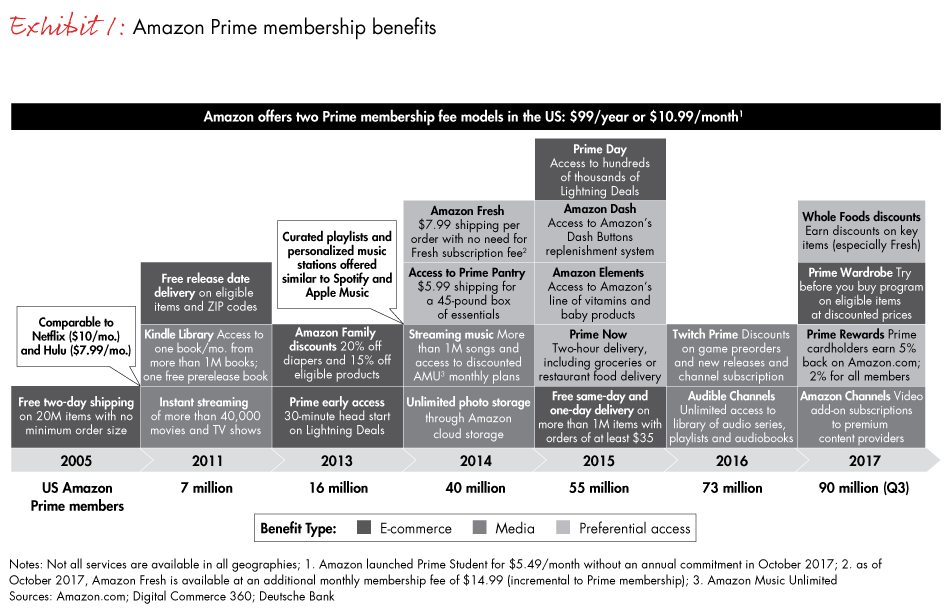
View the full PDF for a list of references
About Our Research Partners
Earnest Research, a data innovation company, offers market and consumer research products derived from the transaction data of millions of anonymous US-based adult consumers to support consultants, investors and corporate clients. Leveraging a proprietary full-digital-wallet methodology and longitudinal cohorting, Earnest Research provides insight into consumer behavior trends and an unbiased look into competitive market dynamics with a high degree of accuracy against company-reported metrics. For details, visit https://earnestresearch.com or contact Elina Baygildina (ebaygildina@earnestresearch.com).
Market Track creates stronger marketing outcomes for companies and a more relevant shopper journey for consumers through the curation and aggregation of proprietary data streams, offering a one-stop shop for mission-critical market intelligence accessible at any time and from anywhere. With over 2,100 clients and solutions across all business lines, Market Track is committed to delivering market intelligence to increase marketing effectiveness for manufacturers, retailers and agencies. For details, visit https://markettrack.com.
Research Now is a global leader in digital research data for better insights and business decisions. Founded in 1999, the company was a pioneer in originating online data sampling. The company provides research data solutions for its 3,000 market research, consulting, media and corporate clients through access to more than 11 million deeply profiled business professionals and consumers. Research Now currently operates in more than 40 countries around the globe with locations in the Americas, Europe, the Middle East and Asia-Pacific. For more information, please go to www.researchnow.com.
ROI Consultancy Services, a provider of Bain Certified Net Promoter Score studies, offers full-service research, marketing and sales automation, and digital agency support to consultants, investors and corporate clients. For details, visit www.roiconsultancyservices.com or contact Noah Seton (noah.seton@roirocket.com).
SimilarWeb is a pioneer of market intelligence, providing granular insights about any website or app across all industries in every region to help brands improve their decision-making and win market share. The solution is used across organizations and industries to understand industry dynamics, reveal competitor strategies, benchmark performance, and identify new opportunities in marketing, sales, strategy, business development, investments and more. SimilarWeb has raised more than $112M and has nearly 400 employees across eight global offices. Learn more at www.similarweb.com.
1 The Net Promoter Score® is derived by asking consumers, "On a scale of zero to 10, how likely would you be to recommend this company (or this product) to friends and colleagues?" Ratings of 9 or 10 indicate promoters; 7 and 8, passives; and zero through 6, detractors. The score is simply the percentage of promoters minus the percentage of detractors. Net Promoter®, Net Promoter System®, Net Promoter Score® and NPS® are registered trademarks of Bain & Company, Inc., Fred Reichheld and Satmetrix Systems, Inc.